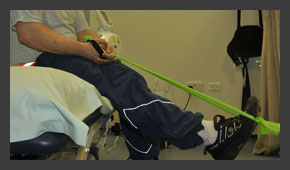Did you know that foot and ankle issues bring millions of Americans into their local podiatrist's office each year? Sometimes it's an injury that brings people into the doctor's office, while others may be experiencing new pain, stiffness, swelling or suffering from various deformities. Many of these patients are diagnosed and treated for minor foot conditions, such as bunions, corns, flat feet, athlete's foot, warts, or ingrown nails and others are treated for more severe conditions or injuries. Here are the five most common foot and ankle injuries:
Plantar Fasciitis
Typically plantar fasciitis symptoms are described by patients as feeling severe pain in the heel or ball of their foot, when taking their first few steps out of bed in the morning. Once the band has time to stretch, the pain will often subside significantly but will continue to flare up again after each time that it is rested. A diagnosis of plantar fasciitis means you have inflamed the tough, fibrous band of tissue (fascia) connecting your heel bone to the base of your toes. Plantar Fasciitis is one of the most common foot and ankle injuries in adults. Nearly two million patients are treated for this problem each year. Some cases of Plantar Fasciitis can be resolved simply with rest, ice and stretching, while others will need to take anti-inflammatory medication, wearing a heel pad, a night splint and / or custom orthotics before finding relief. Wearing supportive shoes is a must during the healing process.
Achilles Tendonitis
The Achilles Tendon runs lengthwise down the back of the ankle and connects the two primary calf muscles to the bone in the heel. It is the largest tendon in the body and is particularly susceptible to inflammation because of overuse. When the tendon is overused and becomes inflamed and painful, the condition is called Achilles tendonitis and can be addressed with tendonitis ankle treatment. One of the concerns with those suffering from Achilles tendonitis is that they are more prone to an Achilles tear or full rupture after repetitive inflammation and damage have been built up over time. An Achilles tendon tear injury can also occur because of sudden trauma. If a patient hears a pop or feels and experiences severe heel pain after landing a jump, the Achilles tendon may have torn or ruptured. A Podiatrist will be able to determine the nature and extent of the injury and proper treatment.
Ankle Sprain
The bands of connective tissue that provide stability and strength to joints by attaching bones to other bones are called ligaments. In the ankle, ligaments keep the joint stable and from moving too far from side to side. When a sprain happens, one or more ligaments have been stretched to far or torn. High ankle sprains are among the most common foot and ankle injuries. They impact the syndesmotic ligament, which runs from the knee down into the ankle. An ankle sprain can be more painful than a broken bone sometimes. While most sprains are minor and will heal with rest and ice, if swelling and pain persist, it is important to seek the help of a Podiatrist. If a severe ankle sprain is not treated, it can can weaken the ankle over time and even cause repeated sprains or lead to other ankle injuries. It is also common that if someone has repeated ankle sprains, they can get arthritis.
Stress Fractures
Repetitive and excessive overuse and force to the bones of the foot can cause damage and even small, microscopic fractures. Usually, acute fractures occur because of a traumatic injury, while stress fractures are the result of repetitive impact, accumulating over time. Some patients will experience pain for months and continue to overuse their foot unaware that they are making it worse. When the bones and their supporting muscles do not have time to heal between exercise sessions, tiny cracks in the bones, called stress fractures, can occur. Another cause of stress fractures is a change in usual physical activity. For example, during the nationwide shut down, a lot of people started walking a few times a day. This sudden increase of activity or a change in workout surface can both cause this type of injury.
Fractures of the Ankle
Ankle sprain vs a broken ankle can only be diagnosed by a medical professional and an x-ray. Unlike an ankle sprain that affects the ligaments around the bones, a fracture in one of the bones of the ankle is often the result of a traumatic injury or impact. They are very different injuries and can occur at the same time and this is why it's important to not self-diagnose. Any ankle fracture should be taken seriously and treated by a Podiatrist or Orthopedic ankle specialist. If there is a bone protruding from the skin, the injury must be addressed immediately to reduce the risk of infection. If you're dealing with the symptoms of a foot or ankle issue, it is recommend to make an appointment with a Podiatrist or Orthopedist to receive a proper diagnosis and develop an effective treatment plan.
Written by
Dr. Jeffrey S. Hurless
DPM, FACFAS Board Certified Foot & Ankle Surgeon/Podiatrist
Medical Director, HealthyFeetStore.com
 |
 |
